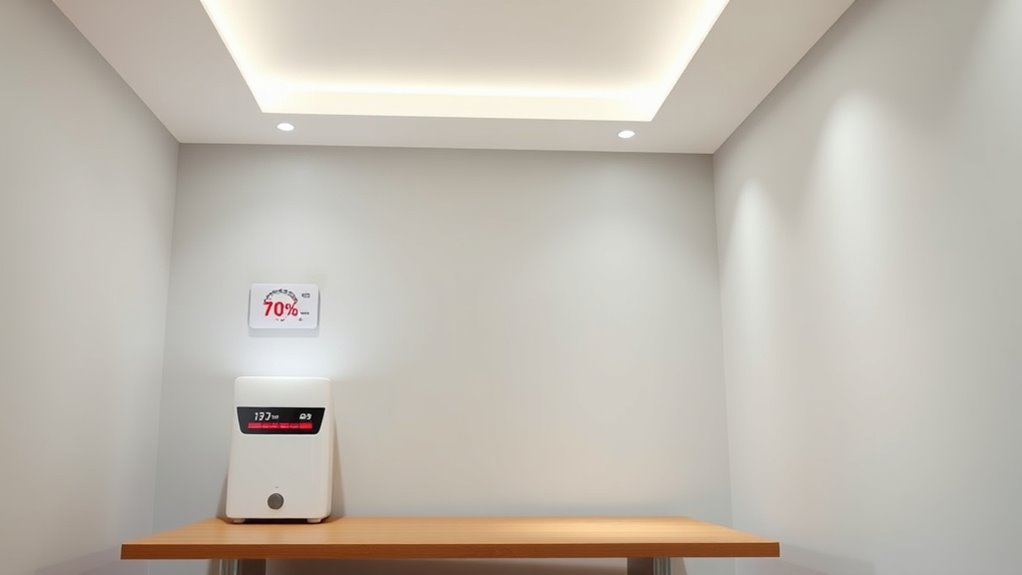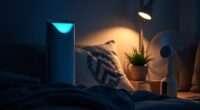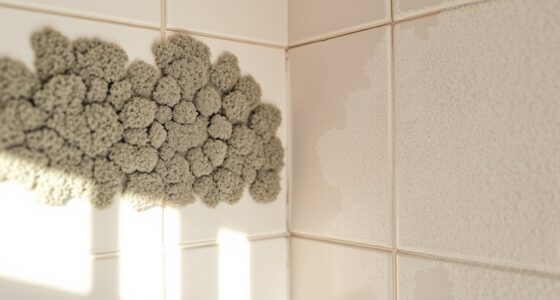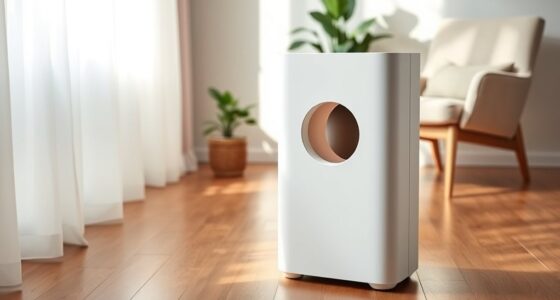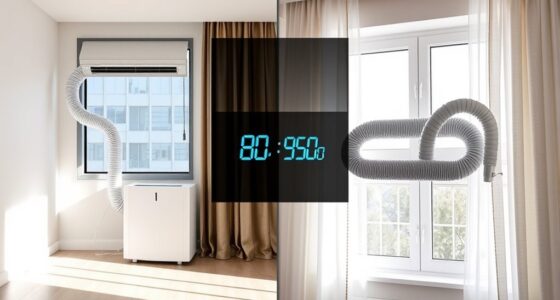If your room feels damp or shows signs of mold, aim to keep the humidity between 40% and 50%. Humidity above 60% encourages mold spores to settle and grow. Using a hygrometer helps you monitor moisture levels accurately, while dehumidifiers and good ventilation keep humidity in check. Maintaining these target RH numbers creates an environment that discourages mold. Keep going to discover more effective ways to control moisture and protect your home.
Key Takeaways
- Maintain indoor relative humidity between 30% and 50% to inhibit mold growth.
- Keep humidity levels below 60% to significantly reduce mold risk.
- Use reliable hygrometers to monitor RH and ensure it stays within the safe range.
- Employ dehumidifiers and proper ventilation to consistently control humidity levels.
- Regularly calibrate sensors and log data to maintain optimal indoor moisture control.
Understanding the Relationship Between Humidity and Mold Growth
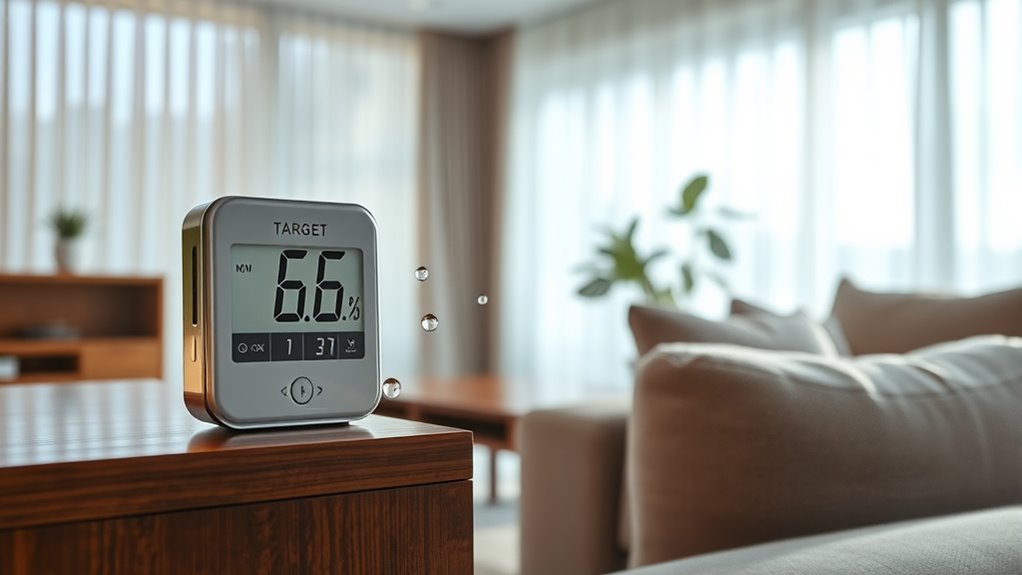
Since mold thrives in damp environments, understanding how humidity affects its growth is essential for mold prevention. Mold spores are tiny and float through the air, waiting for the right conditions to settle and grow. When humidity levels are high, these spores absorb moisture from the air, enabling them to develop into mold. Using humidity sensors helps you monitor indoor moisture levels accurately, giving you real-time data to act quickly. If the humidity rises above the safe threshold, spores can start colonizing surfaces like walls, ceilings, and furniture. Keeping humidity in check prevents mold spores from activating, reducing the risk of mold growth. Regularly checking humidity levels with sensors allows you to maintain a dry environment, which is vital for mold prevention. Additionally, understanding the integration of AI in devices can help automate humidity control for more effective mold prevention.
The Optimal Relative Humidity Range to Prevent Mold

Maintaining the right humidity levels is key to preventing mold growth. Ideally, you should keep your indoor humidity between 30% and 50%. If you notice signs of excess moisture, like musty odors or condensation, it’s time to act to keep mold at bay.
Ideal Humidity Levels
To effectively prevent mold growth, maintaining your indoor humidity levels within a specific range is vital. Aim for a relative humidity between 40% and 60%. This range discourages mold spores from thriving while keeping your environment comfortable. Use humidity sensors to monitor levels accurately and adjust your ventilation or dehumidifiers as needed. Consider mold-resistant materials for walls and insulation to add an extra layer of protection. Visualize this range as a balanced zone:
| Humidity Level | Environment Description |
|---|---|
| 40-50% | Dry, mold-resistant atmosphere |
| 50-60% | Slightly moist, safe zone |
| Above 60% | Risk of mold growth |
Keeping within this range helps you create an inhospitable environment for mold while maintaining comfort. Monitoring indoor humidity levels regularly is essential for consistent mold prevention.
Signs of Excess Moisture
Excess moisture often reveals itself through clear signs that your home’s humidity levels are too high. You might notice a musty smell or visible mold spores on walls, ceilings, or other surfaces. Condensation on windows and metal fixtures is another warning sign. Using humidity sensors can help you monitor indoor humidity accurately, so you catch issues early. If humidity exceeds the suitable range, mold spores find the perfect environment to grow, spreading quickly in damp areas. You may also see peeling paint or warped wood, indicating excess moisture. Paying attention to these signs and maintaining proper humidity levels prevents mold growth and protects your home’s health. Regularly checking humidity sensors ensures you stay within the ideal RH range to keep mold at bay.
How to Measure Indoor Humidity Levels Accurately
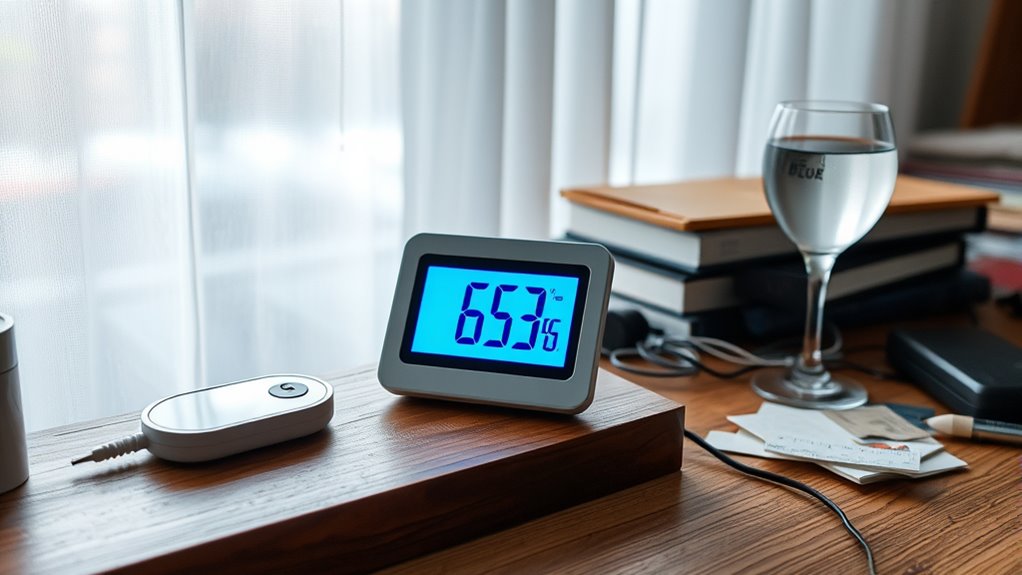
Accurately measuring indoor humidity levels is essential for preventing mold growth, and the best way to do this is by using a reliable hygrometer. Choose a device with quality humidity sensors for precise readings. To guarantee accuracy, regularly calibrate your hygrometer, especially if it’s digital or analog. Proper calibration helps avoid false readings that could lead to unnecessary concern or overlooked issues. Incorporating AI-powered tools can further enhance measurement accuracy and ensure optimal indoor conditions.
Signs That Your Room Is Too Humid
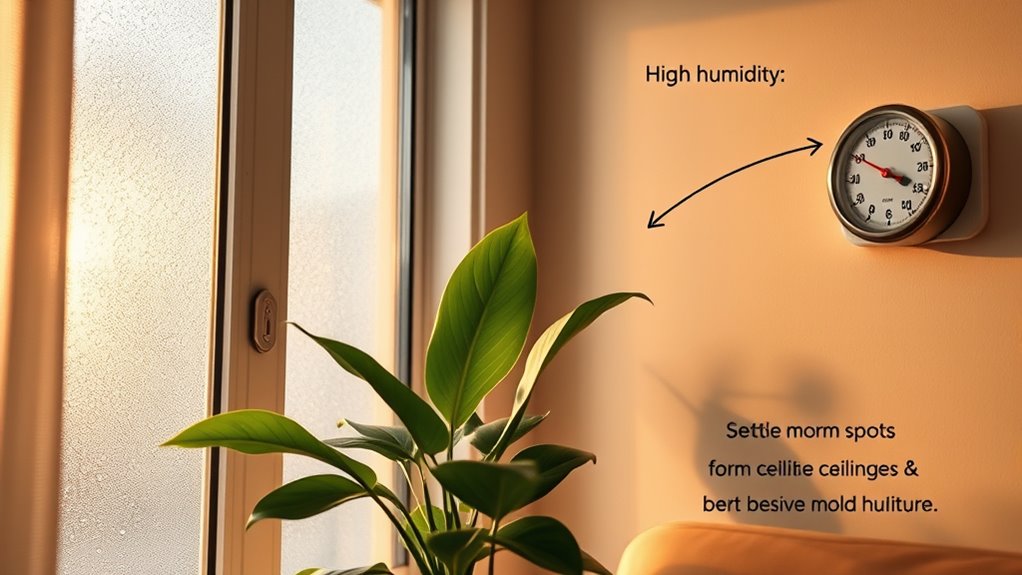
When your indoor humidity levels climb too high, you’ll notice several telltale signs that your room is too humid. Poor air quality is a common indicator, as excess moisture can make the air feel heavy and moldy smells may develop. You might also see visible mold spots on walls or ceilings, signaling persistent moisture problems. Increased condensation on windows and surfaces is another sign, suggesting humidity is out of control. High humidity can attract pests like silverfish or cockroaches, which thrive in moist environments, complicating pest control efforts. Additionally, you may experience stuffy air and difficulty breathing, especially if ventilation isn’t adequate. Recognizing these signs early helps you address excess humidity before mold growth becomes a serious issue. Proper humidity levels are crucial for maintaining a safe and comfortable indoor environment, which can be supported by home security systems that monitor environmental conditions.
Practical Strategies to Reduce Excess Humidity

Controlling indoor humidity starts with practical adjustments you can make around your home. Use humidity sensors to monitor moisture levels accurately, so you’re always aware of excess humidity. Installing moisture barriers in basements, crawl spaces, and walls prevents moisture intrusion from outside, reducing overall humidity. Keep windows and doors well-sealed to prevent drafts that bring in humid air. Ventilate bathrooms and kitchens with exhaust fans during and after activities that generate moisture. Regularly inspect and repair leaks or damp spots to avoid hidden mold growth. Here’s a quick overview:
| Action | Why It Helps | Tips |
|---|---|---|
| Use humidity sensors | Precise moisture control | Place in central rooms |
| Install moisture barriers | Stop outside moisture intrusion | Professional installation |
| Seal gaps and leaks | Prevent humid air entry | Use weatherstripping |
| Ventilate properly | Remove excess moisture | Use exhaust fans |
| Check for leaks | Avoid hidden dampness | Schedule regular inspections |
Using Dehumidifiers Effectively to Control Moisture

Using dehumidifiers effectively can greatly reduce indoor moisture levels and prevent mold growth. To maximize their efficiency, focus on proper dehumidifier placement—set it in central locations away from walls and obstructions to guarantee good airflow. Avoid placing it directly against furniture or drapes, which can hinder performance. Adjust the power settings based on humidity levels; set the dehumidifier to maintain a relative humidity between 30-50%. During humid seasons or in damp areas, increase the settings temporarily, then lower them once the desired RH is achieved. Regularly empty the water tank and clean the filters to keep the unit running smoothly. Proper placement and correct power settings help the dehumidifier effectively control moisture, safeguarding your space from mold. Additionally, understanding regional climate factors can help you better manage indoor humidity levels effectively.
Ventilation Tips to Keep Humidity in Check
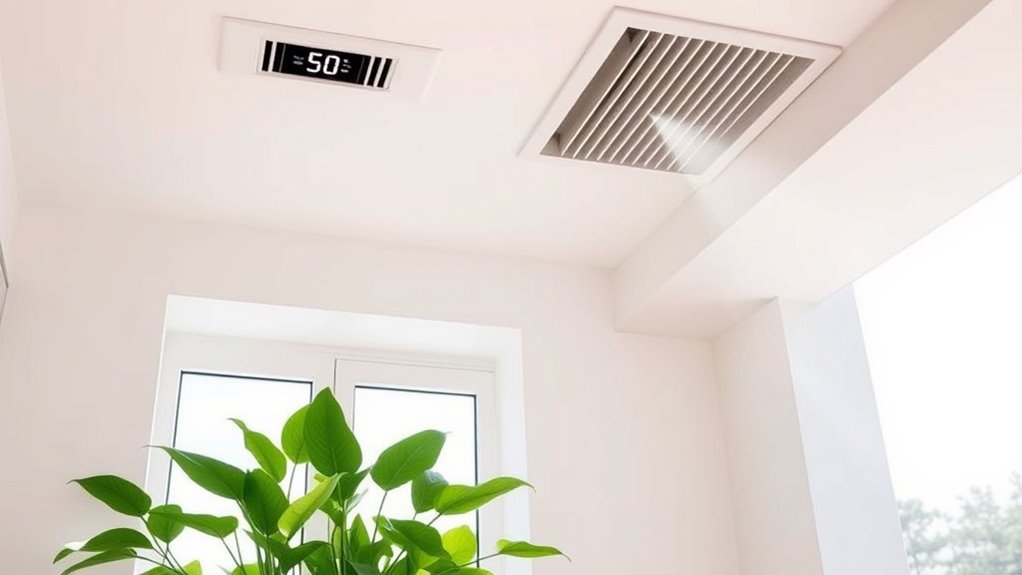
Proper ventilation plays a crucial role in keeping indoor humidity levels in check. Install humidity sensors to monitor moisture levels accurately, so you know when ventilation needs adjustment. Use ventilation fans in high-moisture areas like kitchens and bathrooms to expel humid air effectively. Make sure your fans are powerful enough to circulate air and are used consistently during and after activities that generate moisture. Keep vents open when weather permits to promote fresh air exchange. Regularly clean exhaust fans and vents to prevent dust buildup, which can reduce their efficiency. Proper headphone connection prevents excess humidity from lingering, reducing mold risk. Combining humidity sensors with well-placed ventilation fans ensures your home stays dry and comfortable, helping you maintain ideal RH levels effortlessly.
The Role of Air Circulation in Mold Prevention
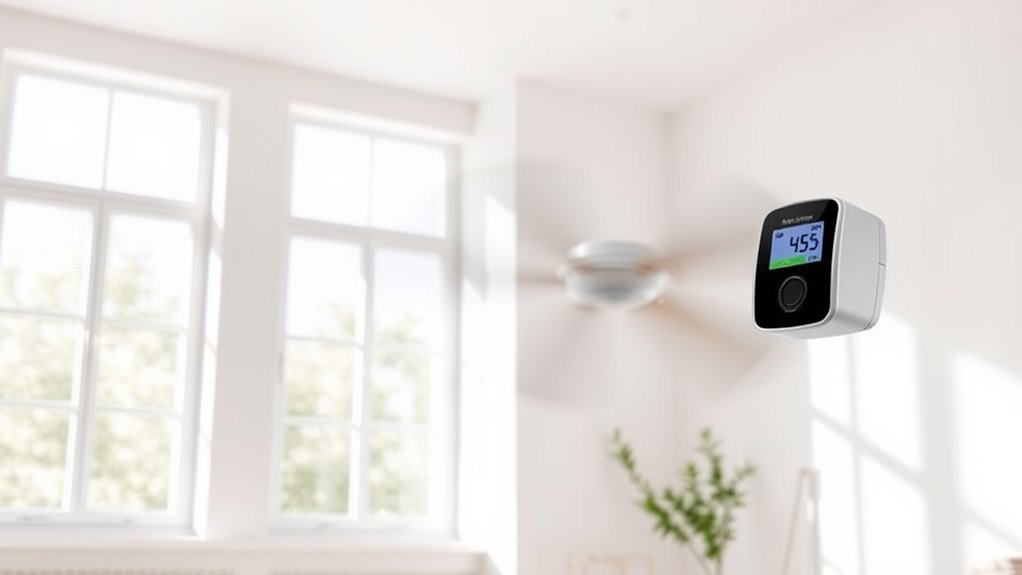
Effective air circulation complements ventilation efforts by actively dispersing humid air and preventing moisture pockets from forming. Proper airflow patterns help maintain consistent humidity levels and reduce mold risk. Using cross ventilation techniques, you can create a steady flow of fresh air across rooms, discouraging stagnant, damp spots. This movement prevents moisture buildup that mold needs to thrive. To optimize air circulation, consider the following:
- Position windows opposite each other for effective cross ventilation
- Use fans to enhance airflow in areas prone to humidity
- Keep interior doors open to promote circulation between rooms
- Avoid obstructions that block airflow paths
- Understanding humidity control is essential for maintaining a healthy environment and preventing mold growth.
Implementing these strategies ensures humid air doesn’t linger, lowering mold chances and keeping your environment healthier.
Long-term Maintenance for a Mold-Resistant Environment
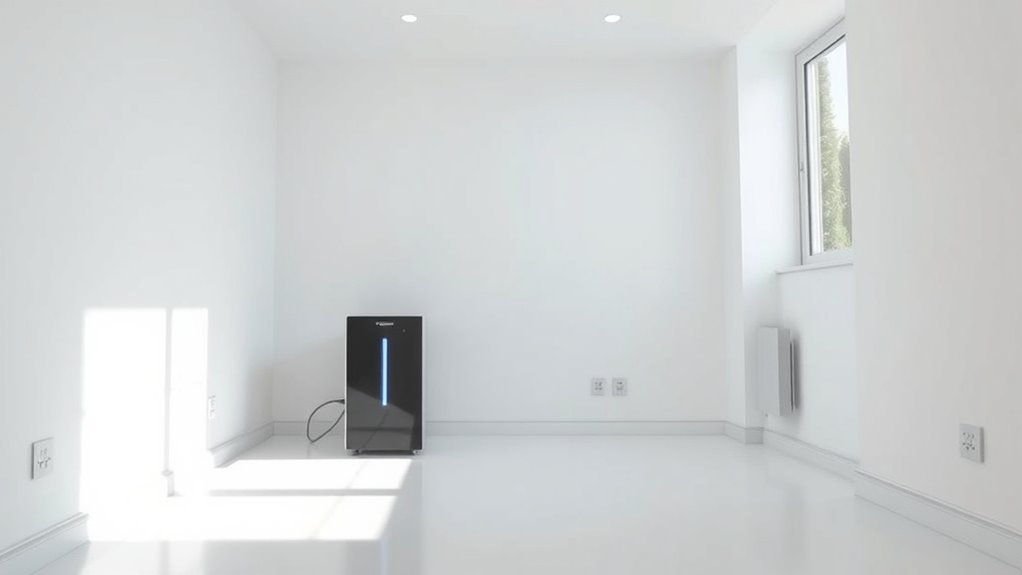
To keep your space mold-resistant, you need to stay on top of humidity levels with regular monitoring. Make sure you’re practicing routine ventilation to allow moisture to escape and air to circulate properly. These simple steps help maintain a consistent environment that discourages mold growth over the long term. Additionally, controlling indoor humidity through dehumidifiers or air conditioning can further reduce the risk of mold development.
Consistent Humidity Monitoring
Since maintaining a consistent humidity level is key to preventing mold growth, you’ll need to monitor your indoor environment regularly. Using reliable humidity sensors helps you track moisture levels accurately, ensuring they stay within the ideal range. Incorporate mold resistant paints in vulnerable areas for an added layer of protection. Regular checks can prevent surprises and help you respond quickly if humidity rises unexpectedly. Keep these practices in mind:
- Install digital humidity sensors in key rooms
- Calibrate sensors periodically for accuracy
- Use mold resistant paints in bathrooms and basements
- Log humidity readings to identify patterns
- Staying aware of data privacy challenges can help protect your personal information and ensure your monitoring devices are secure.
Consistent monitoring allows you to maintain suitable RH levels, reducing mold risk and creating a healthier living space.
Routine Ventilation Practices
Regularly ventilating your home is essential for long-term mold prevention because it helps control moisture buildup and freshens indoor air. Use humidity sensors to monitor indoor humidity levels and identify when ventilation is needed. Make it a habit to open windows or run exhaust fans during and after activities that generate moisture, like cooking or showering. Installing moisture barriers in areas prone to dampness, such as basements or crawl spaces, further reduces excess moisture that fosters mold growth. Consistent airflow prevents humidity from rising to mold-friendly levels and maintains a healthier environment. By combining routine ventilation with humidity sensors and moisture barriers, you create a proactive system that minimizes mold risks and supports long-term home integrity.
Frequently Asked Questions
What Are the Ideal RH Levels for Different Rooms in My Home?
For ideal comfort and mold prevention, keep your home’s humidity levels between 30-50%. Use humidity sensors to monitor these levels accurately. Bedrooms should be around 40-50%, living areas about 30-50%, and basements slightly lower or maintained with a dehumidifier needs to prevent excess moisture. Adjust your dehumidifier accordingly to maintain these targets, ensuring a healthier environment and preventing mold growth.
How Does Outdoor Humidity Influence Indoor Mold Growth?
Outdoor moisture markedly influences indoor mold growth, especially during seasonal changes when humidity levels fluctuate. When outdoor humidity is high, it can seep inside through leaks, windows, or ventilation, raising your indoor RH. You should monitor these changes and adjust your dehumidifiers or ventilation accordingly. Keeping indoor humidity below 60% helps prevent mold, even when outdoor moisture levels are high, so stay vigilant during humid seasons.
Can Mold Grow at Humidity Levels Below 50%?
Mold growth typically slows down at humidity levels below 50%, but it can still occur if there are other moisture sources. Humidity thresholds are key in preventing mold, yet even slightly higher levels can promote growth in certain conditions. You should aim to keep indoor humidity below 50% to effectively inhibit mold development. Regular monitoring and controlling moisture sources help maintain the ideal environment for mold prevention.
Are There Specific Materials More Susceptible to Mold at High Humidity?
Did you know that porous materials like drywall and carpet are 50% more prone to mold growth? These materials are particularly mold sensitive surfaces, making them more susceptible at high humidity levels. Materials prone to mold include fabric, wood, and paper, as they trap moisture easily. To prevent mold, keep humidity below 60%, and regularly inspect these surfaces for signs of mold, especially in damp or poorly ventilated areas.
How Often Should I Check Indoor Humidity to Prevent Mold?
You should check your indoor humidity levels at least once a week to prevent mold. Use reliable humidity sensors to monitor the RH accurately and guarantee it stays between 30-50%. Regular checks help you catch any spikes early, allowing you to take quick action like ventilating rooms or using a dehumidifier. Consistent monitoring is key to effective mold prevention and maintaining a healthy indoor environment.
Conclusion
By keeping your room’s humidity between 30-50%, you’re hitting two birds with one stone—preventing mold and creating a comfortable space. Regularly measure and control moisture levels, stay vigilant for signs of excess humidity, and use dehumidifiers and ventilation wisely. Remember, a stitch in time saves nine; taking these steps now prevents bigger problems down the road. Keep moisture in check, and your home will stay healthy and mold-free for the long haul.
